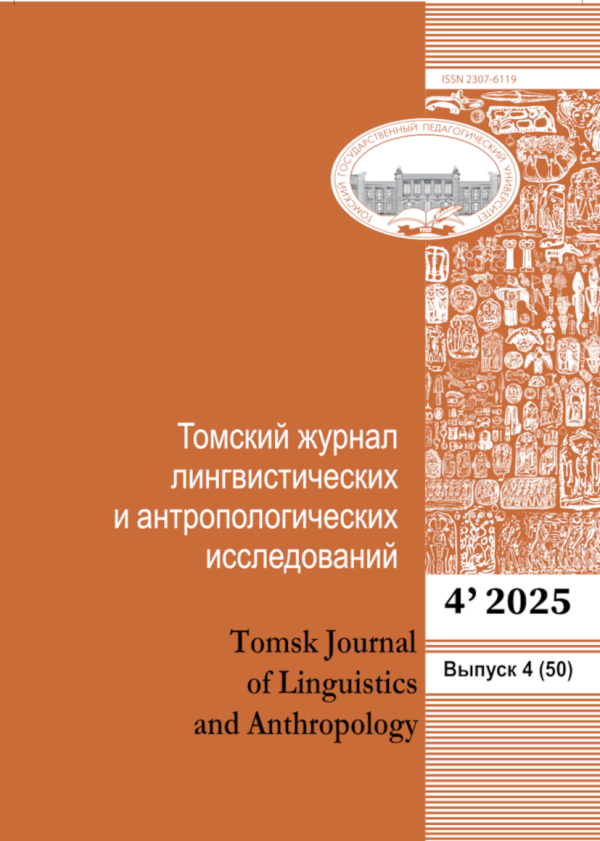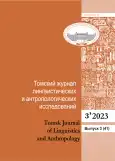Выражение аблативных значений в нанийских языках
- Авторы: Оскольская С.А.1, Стойнова Н.М.2
-
Учреждения:
- Институт лингвистических исследований РАН
- Гамбургский университет
- Выпуск: № 3 (2023)
- Страницы: 71-89
- Раздел: ЛИНГВИСТИКА
- URL: https://bakhtiniada.ru/2307-6119/article/view/270302
- DOI: https://doi.org/10.23951/2307-6119-2023-3-71-89
- ID: 270302
Цитировать
Полный текст
Аннотация
Рассматриваются средства выражения аблативных значений в нанийских языках: в найхинском, джуенском, горинском и бикинском диалектах нанайского языка, ульчском, уильтинском, а также в курурмийском языке. В рамках исследования был составлен список контекстов с аблативными и смежными с аблативными значениями. Исследование выполнено на базе текстовых данных из разных источников: полевых записей авторов, архивных и опубликованных текстов. Полученная база данных позволяет выявить несколько кластеров языков, значений и самих аблативных показателей. Так, на основании набора аблативных показателей можно выделить три группы идиомов: найхинский и джуенский нанайский; горинский нанайский и уильтинский, а также случайная группа из бикинского нанайского и ульчского. Курурмийский не попадает ни в одну из групп. Аблативные показатели, представленные в нанийских идиомах, распадаются на следующие группы по набору выражаемых ими значений: собственно аблативные показатели, аблативно-инструментальный суффикс -ǯi, пролативные падежные показатели выражающие около-пролативные значения в аблативной зоне, и более широкий локативно-пролативный показатель -la, сочетающий около-пролативные значения и источник информации и передачи. В нанийских языках можно выявить три стабильных модели полисемии внутри аблативной зоны: центральные аблативные значения, около-пролативные значения, физическую и метафорическую передачу. Наконец, языки делятся на два кластера по дистрибуции средств выражения внутри аблативной зоны: первая группа включает в себя найхинский и джуенский нанайский, кур-урмийски и, возможно, бикинский нанайский; второй кластер формируют уильтинский и ульчский. Горинский нанайский выделяется среди всех нанийских идиомов.
Об авторах
Софья Алексеевна Оскольская
Институт лингвистических исследований РАН
Автор, ответственный за переписку.
Email: sonypolik@mail.ru
кандидат филологических наук, старший научный сотрудник Санкт-Петербург, Российская Федерация
Наталья Марковна Стойнова
Гамбургский университет
Email: stoynova@yandex.ru
кандидат филологических наук, приглашенный исследователь Гамбург, Германия
Список литературы
- Аврорин В. А. Грамматика нанайского языка. Т. 1. М.– Л.: Изд-во Академии наук СССР, 1959.
- Аврорин В. А. Ульчские тексты. Материалы для грамматических и этнографических исследований (Морфология имени в сибирских языках). Новосибирск, 1981.
- Бельда Р. А., Булгакова Т. Д. Нанайские сказки (Языки и культуры народов Дальнего Востока России). Fürsten-berg: Verl. der Kulturstiftung Sibirien, SEC Publ., 2012.
- Ганенков Д. С. Типология падежных значений // В. А. Плунгян (ред.). Грамматикализация пространственных значений (Исследования по теории грамматики 2). М.: Русские словари, 2002. С. 35–56.
- Икегами Дз. Сказания и легенды народа уйльта // Tungusic Languages and Cultures. 2007. No. 38.
- Новикова К. А. Очерки диалектов эвенского языка. М.: Изд-во Академии наук СССР, 1960.
- Петрова Т. И. Ульчский диалект нанайского языка. М.: Государственное учебно-пед. изд-во, 1936.
- Петрова Т. И. Язык ороков (ульта). Л.: Наука, 1967.
- Путинцева А. П. Тексты на горинском нанайском, записанные в 1935 г. Рукопись // Личный архив Е. П. Данченко.
- Рамстедт Г. Й. Введение в алтайское языкознание: морфология. М.: Изд-во иностранной литературы, 1957.
- Сем Л. И. Очерки диалектов нанайского языка. Бикинский (уссурийский) диалект. Л.: Наука, 1976.
- Сем Л. И. Тексты на ульчском языке, записанные в 1970-х гг. Аудиозаписи // Коллекция Ин-та лингвистических исследований РАН.
- Стойнова Н. М. Эссив, латив и пролатив: «локативный» падеж в нанайском языке // Урало-алтайские исследования. 2015. № 4(19). С. 59–80.
- Суник О. П. Кур-урмийский диалект. Исследования и материалы по нанайскому языку. Л.: Учпедгиз, 1958.
- Суник О. П. Существительное в тунгусо-маньчжурских языках. Л.: Наука, 1982.
- Суник О. П. Ульчский язык: исследования и материалы. Л.: Наука, 1985.
- Ченки А. Современные когнитивные подходы к семантике: сходства и различия в теориях и целях // Вопросы языкознания. 1996. № 2. С. 68–78.
- Benzing J. Die tungusischen Sprachen: Versuch einer vergleichenden Grammatik. Wiesbaden: Verlag der Akademie der Wissenschaften und der Literatur in Mainz, 1955. P. 949–1099.
- Creissels D. Spatial Cases // Malchukov, A. L., Spencer A. (eds.) The Oxford Handbook of Case. 1st ed. Oxford: Oxford University Press, 2008. P. 609–625.
- Haspelmath M. Differential place marking and differential object marking. STUF – Language Typology and Universals. 2019. No. 72(3). P. 313–334.
- Ikegami J. The Substantive Inflection of Orok. Gengo Kenkyu // Journal of the Linguistic Society of Japan. 1956. No. 30. P. 77–96.
- Kalinina E., Goussev V., Sumbatova N. Toldova S. Documentation of endangered Tungusic languages of Khabarovskiy Kray. URL: http://hdl.handle.net/2196/00-0000-0000-0002-2FAD-A
- Narrog H. A Diachronic Dimension in Maps of Case Functions // Linguistic Discovery. 2010. No. 8(1). DOI: 10.1349/ PS1.1537-0852.A.352
- Schmidt P. The language of the Samagirs. Acta Universitatis Latviensis. 1928. No. 19. P. 219–249.
- Tsumagari T. Grammatical Outline of Uilta // Journal of the Faculty of Humanities and Human Sciences. 2009. No. 4. P. 1–21.
- Zikmundová V. Spoken Sibe: morphology of the inflected parts of speech. Prague: Karolinum Press, 2013.
Дополнительные файлы







